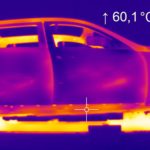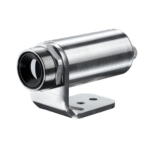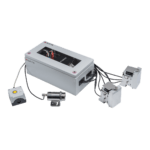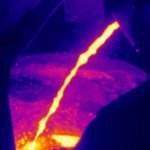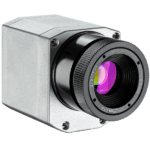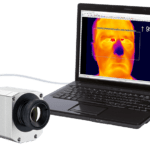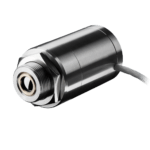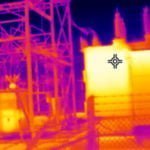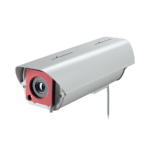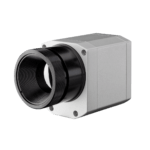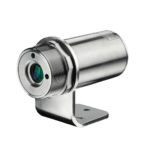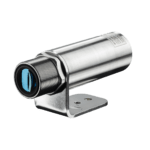Thermal Detector
In addition to quantum detectors, thermal detectors are a second type of infrared detectors. They are based on a temperature change of the element through the absorption of electromagnetic radiation. The change in temperature causes a change in a temperature-dependent property of the thermal detector, which is evaluated electrically and is a measure of the absorbed energy.
Radiation Thermoelement (Thermopile)
When the junction of two different metals is heated, an electrical voltage proportional to the temperature is produced due to the thermoelectric effect. This effect has been utilized for many years for technical contact temperature measurements using thermoelements. If the heating of the junction is caused by the absorption of radiation, then this component is known as a thermopile.
The image shows thermoelements made of bismuth/antimony which are arranged in a circular pattern on a detector area of a chip. The heating of the detector area leads to a signal voltage being produced, which can be accessed at the bond island.
Pyroelectric Detectors
The so-called pyroelectric detectors are based on the pyroelectric effect. The sensitive detector element consists of a pyroelectric material with two electrodes attached by evaporation deposition. The basic structure of a pyroelectric element is shown in the image below.
The temperature change in the detector element created by the absorption of infrared radiation causes a change in surface charge as a result of the pyroelectric effect. This results in an electrical output signal which is processed in a pre-amplifier. Due to the way that charge is created in the pyroelectric material, the radiation flow must be continuously interrupted in an alternating manner (chopping). The advantage of the resulting frequency-selective amplification is a good signal-noise ratio.
Bolometer
The so-called bolometer is a special type of thermal detector and is based on the temperature-dependence of an electrical resistance. The sensitive detector element comprises a resistor, whose value changes when heat radiation is absorbed. The change in resistance causes a change in the signal voltage drop across the bolometer resistance. In order to achieve high sensitivity and large specific detectivity, it is necessary to use a material with a high coefficient of temperature of electrical resistance. In bolometers which function at room temperature, both the temperature coefficient of resistance of metals (e.g. black-film and thin-film bolometers) as well as that of semi-conductors (e.g. thermistor bolometers) are used.
With infrared cameras, the most common type of detector used is a Focal Plane Array (FPA) based on thin-film bolometers. The integrated image sensor typically has a size of 20,000 up to 1 million pixels. Here, each pixel is a 17×17 up to 35×35 µm² microbolometer. By using VOX (vanadium oxide) or amorphous silicon as alternative technologies for FPAs, a drastically improved price-performance ratio can be achieved. Typical detector sizes today are 160×120, 320×240 and 640×480 pixels. To increase measurement precision, the bolometers are thermostated at defined temperatures with a large control accuracy and referenced regularly using an offset correction.
Share article
Contact for Advice and Sales Worldwide
We offer comprehensive advice for your individual applications
Our experienced application engineers ensure competent and reliable customer service in the field. In addition, Optris works closely with numerous distribution partners worldwide.
International
Ferdinand-Buisson-Str. 14
13127 Berlin, Germany
Phone: +49 30 500 197-0
E-Mail: sales@optris.com
Internet: www.optris.com
Managing Director:
Dr.-Ing. Ulrich Kienitz

